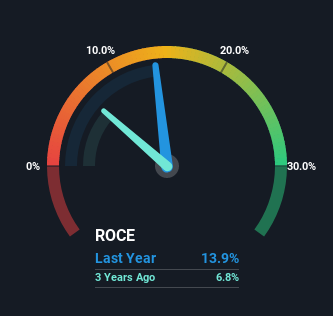- India
- /
- Electrical
- /
- NSEI:BHAGYANGR
Bhagyanagar India (NSE:BHAGYANGR) Shareholders Will Want The ROCE Trajectory To Continue

If we want to find a potential multi-bagger, often there are underlying trends that can provide clues. Ideally, a business will show two trends; firstly a growing return on capital employed (ROCE) and secondly, an increasing amount of capital employed. If you see this, it typically means it's a company with a great business model and plenty of profitable reinvestment opportunities. With that in mind, we've noticed some promising trends at Bhagyanagar India (NSE:BHAGYANGR) so let's look a bit deeper.
What Is Return On Capital Employed (ROCE)?
For those who don't know, ROCE is a measure of a company's yearly pre-tax profit (its return), relative to the capital employed in the business. The formula for this calculation on Bhagyanagar India is:
Return on Capital Employed = Earnings Before Interest and Tax (EBIT) ÷ (Total Assets - Current Liabilities)
0.14 = ₹288m ÷ (₹4.2b - ₹2.2b) (Based on the trailing twelve months to March 2023).
So, Bhagyanagar India has an ROCE of 14%. By itself that's a normal return on capital and it's in line with the industry's average returns of 14%.
View our latest analysis for Bhagyanagar India

Historical performance is a great place to start when researching a stock so above you can see the gauge for Bhagyanagar India's ROCE against it's prior returns. If you want to delve into the historical earnings, revenue and cash flow of Bhagyanagar India, check out these free graphs here.
What The Trend Of ROCE Can Tell Us
Investors would be pleased with what's happening at Bhagyanagar India. The data shows that returns on capital have increased substantially over the last five years to 14%. The company is effectively making more money per dollar of capital used, and it's worth noting that the amount of capital has increased too, by 57%. The increasing returns on a growing amount of capital is common amongst multi-baggers and that's why we're impressed.
On a side note, we noticed that the improvement in ROCE appears to be partly fueled by an increase in current liabilities. Essentially the business now has suppliers or short-term creditors funding about 51% of its operations, which isn't ideal. Given it's pretty high ratio, we'd remind investors that having current liabilities at those levels can bring about some risks in certain businesses.
The Bottom Line
A company that is growing its returns on capital and can consistently reinvest in itself is a highly sought after trait, and that's what Bhagyanagar India has. Since the stock has only returned 37% to shareholders over the last five years, the promising fundamentals may not be recognized yet by investors. So with that in mind, we think the stock deserves further research.
Since virtually every company faces some risks, it's worth knowing what they are, and we've spotted 2 warning signs for Bhagyanagar India (of which 1 is concerning!) that you should know about.
While Bhagyanagar India may not currently earn the highest returns, we've compiled a list of companies that currently earn more than 25% return on equity. Check out this free list here.
Valuation is complex, but we're here to simplify it.
Discover if Bhagyanagar India might be undervalued or overvalued with our detailed analysis, featuring fair value estimates, potential risks, dividends, insider trades, and its financial condition.
Access Free AnalysisHave feedback on this article? Concerned about the content? Get in touch with us directly. Alternatively, email editorial-team (at) simplywallst.com.
This article by Simply Wall St is general in nature. We provide commentary based on historical data and analyst forecasts only using an unbiased methodology and our articles are not intended to be financial advice. It does not constitute a recommendation to buy or sell any stock, and does not take account of your objectives, or your financial situation. We aim to bring you long-term focused analysis driven by fundamental data. Note that our analysis may not factor in the latest price-sensitive company announcements or qualitative material. Simply Wall St has no position in any stocks mentioned.
About NSEI:BHAGYANGR
Slight and slightly overvalued.
Similar Companies
Market Insights
Community Narratives




